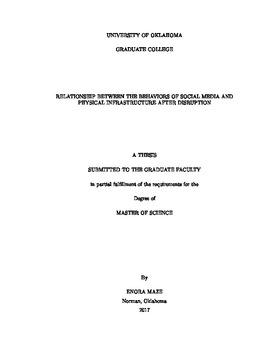| dc.description.abstract | Social media have developed quickly over the years, on a worldwide scale. It has become a major tool for expressing ideas, sharing political opinions, publicity and market trending, assistance, etc., used on a daily basis by millions of people, in several languages, and continuously expanding. This evolution has caught the attention of researchers, as much more data became accessible. One research area concerns the study of social media behavior during natural disasters. These studies try to determine whether social media are social sensors, but only a few focuses on the physical environment. Here, the main objective is to establish whether Twitter is a sensor of the physical environment during a natural disaster.
In order to understand the relationship between Twitter and the physical environment, a data set of tweets is compared to a measurable disruption caused by the natural hazard. The tweets need to be relevant to the disruption, and so are filtered using specific keywords. Then, they are decomposed into a time series, and compared with a time series of the measurable disruption with a cross-correlation function.
Two examples of disruption are studied here, both during Hurricane Sandy in $2012$. The first one compares the behavior of Twitter with the number of power outages, and the second one with the water peak elevations. Both examples do not yield to conclusive results, as no significant correlation is found. However, it doesn't mean that a correlation does not exist at all. The analysis is strongly dependent on the quality of the data set, and unfortunately some values are missing on important time periods on the Twitter data set. Also, the water peak elevations data set do not contain many points, and they are not taken at a regular time interval, which may have biased the analysis. | en_US |
